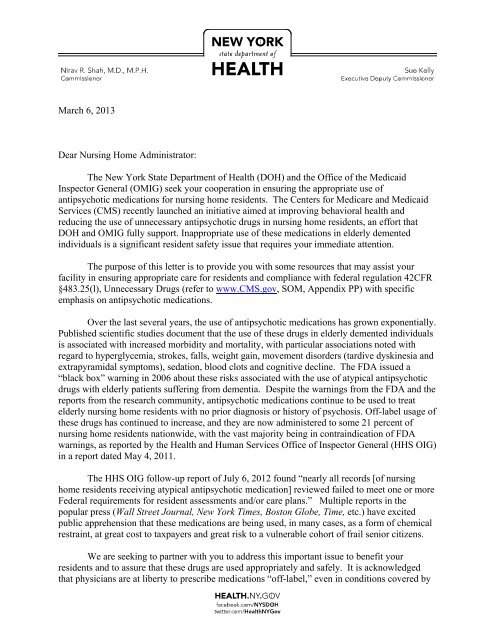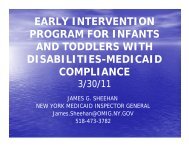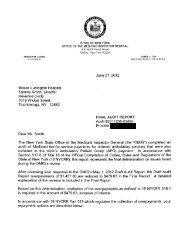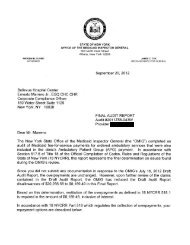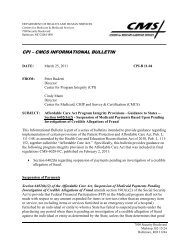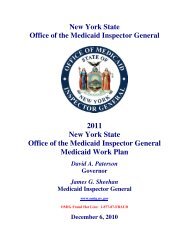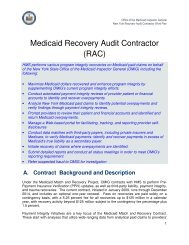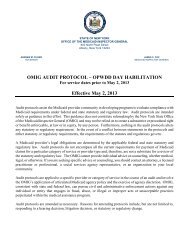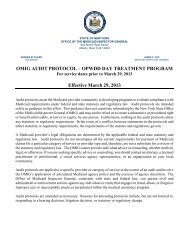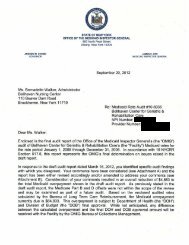Joint OMIG/DOH Letter on Antipsychotics, March 2013
Joint OMIG/DOH Letter on Antipsychotics, March 2013
Joint OMIG/DOH Letter on Antipsychotics, March 2013
You also want an ePaper? Increase the reach of your titles
YUMPU automatically turns print PDFs into web optimized ePapers that Google loves.
<strong>March</strong> 6, <strong>2013</strong><br />
Dear Nursing Home Administrator:<br />
The New York State Department of Health (<str<strong>on</strong>g>DOH</str<strong>on</strong>g>) and the Office of the Medicaid<br />
Inspector General (<str<strong>on</strong>g>OMIG</str<strong>on</strong>g>) seek your cooperati<strong>on</strong> in ensuring the appropriate use of<br />
antipsychotic medicati<strong>on</strong>s for nursing home residents. The Centers for Medicare and Medicaid<br />
Services (CMS) recently launched an initiative aimed at improving behavioral health and<br />
reducing the use of unnecessary antipsychotic drugs in nursing home residents, an effort that<br />
<str<strong>on</strong>g>DOH</str<strong>on</strong>g> and <str<strong>on</strong>g>OMIG</str<strong>on</strong>g> fully support. Inappropriate use of these medicati<strong>on</strong>s in elderly demented<br />
individuals is a significant resident safety issue that requires your immediate attenti<strong>on</strong>.<br />
The purpose of this letter is to provide you with some resources that may assist your<br />
facility in ensuring appropriate care for residents and compliance with federal regulati<strong>on</strong> 42CFR<br />
§483.25(l), Unnecessary Drugs (refer to www.CMS.gov, SOM, Appendix PP) with specific<br />
emphasis <strong>on</strong> antipsychotic medicati<strong>on</strong>s.<br />
Over the last several years, the use of antipsychotic medicati<strong>on</strong>s has grown exp<strong>on</strong>entially.<br />
Published scientific studies document that the use of these drugs in elderly demented individuals<br />
is associated with increased morbidity and mortality, with particular associati<strong>on</strong>s noted with<br />
regard to hyperglycemia, strokes, falls, weight gain, movement disorders (tardive dyskinesia and<br />
extrapyramidal symptoms), sedati<strong>on</strong>, blood clots and cognitive decline. The FDA issued a<br />
“black box” warning in 2006 about these risks associated with the use of atypical antipsychotic<br />
drugs with elderly patients suffering from dementia. Despite the warnings from the FDA and the<br />
reports from the research community, antipsychotic medicati<strong>on</strong>s c<strong>on</strong>tinue to be used to treat<br />
elderly nursing home residents with no prior diagnosis or history of psychosis. Off-label usage of<br />
these drugs has c<strong>on</strong>tinued to increase, and they are now administered to some 21 percent of<br />
nursing home residents nati<strong>on</strong>wide, with the vast majority being in c<strong>on</strong>traindicati<strong>on</strong> of FDA<br />
warnings, as reported by the Health and Human Services Office of Inspector General (HHS OIG)<br />
in a report dated May 4, 2011.<br />
The HHS OIG follow-up report of July 6, 2012 found “nearly all records [of nursing<br />
home residents receiving atypical antipsychotic medicati<strong>on</strong>] reviewed failed to meet <strong>on</strong>e or more<br />
Federal requirements for resident assessments and/or care plans.” Multiple reports in the<br />
popular press (Wall Street Journal, New York Times, Bost<strong>on</strong> Globe, Time, etc.) have excited<br />
public apprehensi<strong>on</strong> that these medicati<strong>on</strong>s are being used, in many cases, as a form of chemical<br />
restraint, at great cost to taxpayers and great risk to a vulnerable cohort of frail senior citizens.<br />
We are seeking to partner with you to address this important issue to benefit your<br />
residents and to assure that these drugs are used appropriately and safely. It is acknowledged<br />
that physicians are at liberty to prescribe medicati<strong>on</strong>s “off-label,” even in c<strong>on</strong>diti<strong>on</strong>s covered by
“black box” warnings. However, given the high risks associated with this particular class of<br />
drugs, the burden is <strong>on</strong> the prescriber, as well as the instituti<strong>on</strong> allowing the practiti<strong>on</strong>er to care<br />
for residents, to ensure that the benefits to be achieved by the prescribing of such medicati<strong>on</strong><br />
outweigh the risks involved.<br />
<str<strong>on</strong>g>DOH</str<strong>on</strong>g> nursing home surveyors are trained and resp<strong>on</strong>sible to complete quality reviews for<br />
unnecessary medicati<strong>on</strong>s with an increased focus <strong>on</strong>, and awareness of the use of antipsychotic<br />
medicati<strong>on</strong>s. Surveyors evaluate, through documentati<strong>on</strong>, interview and observati<strong>on</strong>, such<br />
aspects as n<strong>on</strong>-pharmacological interventi<strong>on</strong>s, gradual dose reducti<strong>on</strong> when indicated, and<br />
interdisciplinary evaluati<strong>on</strong> and review. The nursing home is expected to engage all members of<br />
the interdisciplinary team, including the medical director and attending physicians, in the<br />
development and review of policies and procedures to ensure that the use of antipsychotic<br />
medicati<strong>on</strong>s promotes and/or maintains the resident’s highest practicable mental, physical and<br />
psycho-social well-being. The medical director, in particular, plays a key role in this effort.<br />
To facilitate compliance with Federal Regulati<strong>on</strong>s 42 CFR §483.25 (see Attachment #1)<br />
regarding the avoidance of unnecessary drugs, two protocols are attached for your c<strong>on</strong>siderati<strong>on</strong><br />
to use as part of your Quality Assurance and Risk Management programs. The first was the<br />
product of working groups of physicians, pharmacists, nurses and senior care specialists from the<br />
<str<strong>on</strong>g>DOH</str<strong>on</strong>g>, <str<strong>on</strong>g>OMIG</str<strong>on</strong>g> and the Albany Medical Center Alzheimer’s Center. (See Attachment #2.) The<br />
sec<strong>on</strong>d was produced by the Partnership to Improve Dementia Care in Nursing Homes, a<br />
nati<strong>on</strong>wide c<strong>on</strong>sortium headed by the Centers for Medicare and Medicaid Services (CMS). (See<br />
Attachment #3.) As noted earlier, CMS’ initiative is aimed at reducing the usage of unnecessary<br />
antipsychotic drugs in nursing homes nati<strong>on</strong>wide by no less than 15 percent by the end of 2012.<br />
(See Attachment #4.)<br />
Attachment #5 is “Guidelines for Management of Alzheimer’s Disease and Related<br />
Dementias,” published by the Nati<strong>on</strong>al Guideline Clearinghouse of the Agency for Healthcare<br />
Research and Quality (AHRQ). Attachment #6 is the “Dear Medical Director” letter from the<br />
American Medical Directors Associati<strong>on</strong> (AMDA), which you may wish to share with your<br />
medical staff.<br />
These attachments are not mandated for adopti<strong>on</strong>, nor does your use of any of these tools<br />
guarantee compliance with regulatory requirements. We hope, however, that these resources<br />
prove useful to you in your endeavors to assure the highest quality of care for your elderly<br />
residents with dementia. We look forward to working with you and thank you in advance for<br />
your immediate efforts <strong>on</strong> this important patient safety initiative.<br />
Sincerely,<br />
Nirav R. Shah, M.D., M.P.H.<br />
Commissi<strong>on</strong>er of Health<br />
James C. Cox<br />
Medicaid Inspector General<br />
Attachments
Suggested Protocol for Prescribing Antipsychotic Drugs to the Elderly, to promote<br />
compliance with 42 CFR 483.25 F329, Unnecessary Medicati<strong>on</strong>s:<br />
1. Whenever a resident is admitted <strong>on</strong> an antipsychotic medicati<strong>on</strong>, or an<br />
antipsychotic medicati<strong>on</strong> is added to a resident's regimen, the attending<br />
physician must document the medical necessity for the medicati<strong>on</strong> by<br />
identifying the target symptoms/behaviors, and the diagnosis applicable to the<br />
medicati<strong>on</strong> chosen.<br />
2. If usage of this medicati<strong>on</strong> is "off-label" and/or in c<strong>on</strong>traventi<strong>on</strong> of "black<br />
box" FDA warning, attending physician or other prescriber must document<br />
the benefits to be achieved by the medicati<strong>on</strong> and the benefit/risk analysis.<br />
3. Attending physician must document efforts undertaken to work up patient<br />
regarding target behaviors/symptoms: ruling out of infecti<strong>on</strong> (UTI, URI, etc.),<br />
head injury or other trauma, psychological and/or social upset, etc.<br />
4. Attending physician must document the explanati<strong>on</strong> of the benefit/risk<br />
analysis given when informed c<strong>on</strong>sent was obtained from patient or healthcare<br />
proxy/POA.<br />
5. Documentati<strong>on</strong> should include when the medicati<strong>on</strong> is to be initiated, the dose<br />
(and if it is not the lowest dose, the rati<strong>on</strong>ale for a higher dose), anticipated<br />
resp<strong>on</strong>se; a gradual dose reducti<strong>on</strong> plan; a disc<strong>on</strong>tinuati<strong>on</strong> plan or<br />
documentati<strong>on</strong> supporting c<strong>on</strong>tinued use of the medicati<strong>on</strong> and the dosage and<br />
durati<strong>on</strong> at which it will be c<strong>on</strong>tinued.<br />
6. Document specific plan for behavioral assessment and interventi<strong>on</strong>s to<br />
address target symptoms/behaviors.<br />
7. Facility should have policy which addresses the need for the c<strong>on</strong>sultant<br />
pharmacist to review the medicati<strong>on</strong> regimen within 48 hours (not currently<br />
required per CFR; see Attachment 3 from CMS Partnership).<br />
8. Facility's policies and procedures should include reference to applicable<br />
clinical practice guidelines (see Attachment #5, p.7 as example).<br />
9. Document in patient's clinical record resp<strong>on</strong>se (or lack thereof) to medicati<strong>on</strong>,<br />
and any adverse effects; m<strong>on</strong>itoring should be documented by nursing,<br />
physicians, pharmacist, and any psychologist, psychiatrist, Social Worker or<br />
other mental health professi<strong>on</strong>al involved with care of patient. Medicati<strong>on</strong><br />
Regimen Review should be documented by attending physician and<br />
pharmacist <strong>on</strong> regular schedule (m<strong>on</strong>thly at a minimum).<br />
July 2012 This document was drafted by a working group including J<strong>on</strong>athan Cooper, MD of NYS Office of<br />
the Medicaid Inspector General (<str<strong>on</strong>g>OMIG</str<strong>on</strong>g>), James Burnham RPh of <str<strong>on</strong>g>OMIG</str<strong>on</strong>g>, Earl Zimmerman, MD and<br />
Elizabeth Smith-Boivin of Albany Medical Center’s Alzheimer’s Center and Foster Gesten, MD of NYS<br />
Department of Health.


